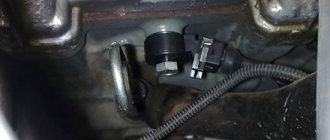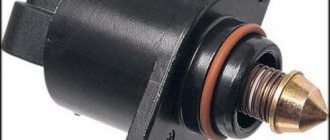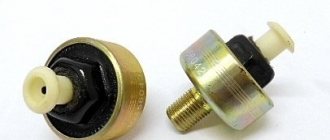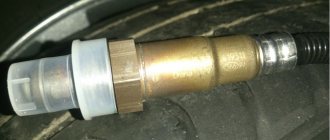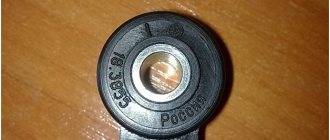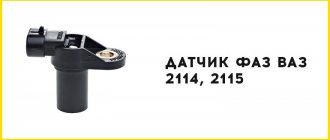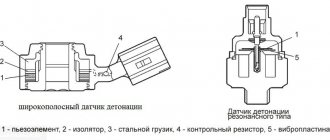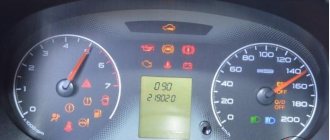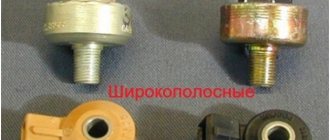The knock sensor (DS) is one of those parts whose importance is difficult to overestimate. The operation of the car's power unit largely depends on its serviceability. Untimely replacement of the element can cause motor failure. In this article we will talk about where the knock sensor is located on the VAZ 2115. We will also list the main signs of failure and describe how to check this part.
What is he responsible for?
The knock controller is a device responsible for vibration in the engine. The functions of the device are as follows:
- track the resulting detonation;
- record problems and send a signal to the computer.
Based on the information received, the ignition timing will change. As a result, detonation will gradually disappear. Without the device, the engine operates in an unstable mode, which leads to increased valve wear.
Design and principle of operation
Principle of operation
As we know, and some only guess, the maximum efficiency of the engine (dynamics, power, fuel consumption) is greatly influenced by the correctly set ignition timing, which, moreover, must optimally adapt to different engine operating modes. Deviations from the optimal ignition timing parameters are as follows:
- A late ignition timing is fraught with deterioration in vehicle dynamics, engine overheating and increased fuel consumption;
- An early ignition timing angle, in turn, manifests itself in the form of microexplosions in the combustion chamber (detonation), which entails a drop in power and increased valve wear (valve burnout).
And in order to eliminate these deviations, the car’s electronic control unit strives to set the ignition timing as large as possible, but at the same time does not allow it to go into the detonation zone, which the knock sensor reports to the controller. The operating principle of this device is based on the piezoelectric effect. The knock sensor is mounted on the engine block.
Replacing the knock sensor VAZ 2110
And since detonation is, in fact, a micro-explosion, when it is present, vibration appears on the engine body, which compresses the piezoelectric plate, as a result of which a potential difference appears at its contacts.
Device
At the moment, the modern automotive industry produces two types of knock sensors - resonant and broadband types.
VAZ knock sensor interchangeability
As you can see in the above photo, each type of sensor has a completely different operating principle:
- A broadband type sensor records and transmits the entire spectrum of noise to the electronic control unit, which, in turn, processes the received signal and independently detects the noise corresponding to detonation.
- The resonant type sensor is tuned to the frequency of micro-explosions, and accordingly sends a signal to the controller only if it is detected.
Attention! Replacing the knock sensor for VAZ 2110, 2112, 2114, 2115 does not accept replacing one type of sensor with another.
The following can be summarized:
- Under conditions when the vehicle is operated under normal conditions (high-quality gasoline, serviceable spark plugs, etc.), the electronic control unit does not use the subsidy sensor circuit and switches the engine to operation in the optimal parameters mode.
- When, for some reason, detonation begins, an impulse from the knock sensor tells the control unit that the ignition timing must be shifted in one direction until the detonation disappears. In this way, the ECU creates optimal operating conditions for the engine under any operating conditions.
- This method of adjusting engine operation is called “closed loop” and is used by the electronic control unit not only when working with the knock sensor, but also in adjusting other important parameters.
Connection diagram
The sensor connection in 2115 is shown in the figure.
3 wires are connected to the installed device. Inside the device there is a sensing element and a signal converter, which includes an operational amplifier, a bridge circuit and an output stage.
The operating principle of the sensing element is based on the Hall effect. Once the received signal is converted, it is transmitted to the controller.
How to replace the sensor
Replacing the mechanism yourself is not difficult. It is located between the second and third cylinders; you need to open the hood and provide yourself with unhindered access. It is important that the engine is turned off at this time. As soon as the DD is detected, it is necessary to disconnect the plug going to the sensor wires.
If the mechanism is broadband, then to complete all the work you will need a key set to “13”. In the case of a resonant device, you should arm yourself with a key set to “22”. You just need to unscrew the nuts from the stud with a “13” wrench or the piezoelectric sensor itself with a “22” wrench. It is also necessary to clean the contacts with sandpaper to remove all dirt and oxidation. This procedure should not be neglected, because the quality of the transmitted signal depends on the state of the contacts.
Oxidation and various types of plaque interfere with the transmission of a high-quality signal. As a consequence, this leads to a decrease in the level and accuracy of the impulse, which will leave its mark on the operation of the car. After which it is necessary to install a new mechanism and reassemble in the reverse order.
Signs of failure of the knock sensor 2115
Fatigue of the device during long-term operation manifests itself as follows:
- reduction in engine power;
- increased fuel consumption;
- increase in unit temperature above normal;
- unstable engine operation;
- the appearance of the smell of gasoline in the car interior;
- The on-board computer displays error codes: 0325, 0326, 0327, 0328.
However, these symptoms do not yet indicate that the sensor has definitely failed. It is guaranteed to occur only when several signs are observed at the same time. After this, the device must be checked. If it really fails, then replacement is required.
How dangerous is detonation combustion and what can cause it?
But if at least one of the conditions is not met, then there is a high probability of detonation combustion, which in the future can cause serious damage. The essence of this combustion is that part of the fuel, due to a number of prevailing factors in the combustion chamber, spontaneously ignites. Moreover, this happens before a spark forms between the spark plug electrodes, that is, the mixture ignites ahead of time.
The peculiarity of detonation combustion is that it is similar to an explosion. Combustion of the mixture occurs much faster and is accompanied by increased pressure and significantly higher temperature than during the normal combustion process of the air-fuel mixture.
The result of such combustion is melting of the piston bottom, burning out of it or the valves. In general, detonation in a power plant can cause enormous damage and require expensive and time-consuming repairs.
The cause of detonation may be:
- low-quality gasoline with a low octane number.
- design features of the power plant (compression ratio in the cylinder, shape of the combustion chamber, position of the spark plug, etc.);
- change in operating conditions in the cylinders (incorrect ignition timing, operation under load, the appearance of a significant layer of soot, deterioration in the quality of the air-fuel mixture).
How to check
Diagnosis of the sensor is first carried out by external examination. Visually, broken wires or oxidation of terminals are immediately noticeable. Troubleshooting restores the operation of the device. Diagnostics of DD is carried out in 2 ways. First method:
- The engine starts.
- The engine operation is brought to 1500-2000 rpm.
- A small metal object is tapped on the sensor body.
- The turnover should increase.
If this is not the case, the element needs to be replaced.
The second method requires a multimeter. Sequence of steps:
- The sensor is removed from the mounting location.
- The multimeter is switched to voltmeter mode and 200 millivolts is set.
- The probes of the device touch the sensor contacts.
- A metal bolt is inserted into the DD hole, which is tapped with an iron object.
- These actions should be reflected on the multimeter.
If the measuring device does not record changes in indicators, this indicates a sensor malfunction.
Voltage standards
The controller is supplied with 20 to 40 mV. In translation - 0.02-0.04V.
Sensor break
If an error occurs, look for a problem in the wiring. It's not always about the breakup. Sometimes the contacts oxidize or the insulation is damaged. To fix the problem, you need to look at the wires. If a malfunction is detected, it must be eliminated. The wires are joined or replaced, and oxidized contacts are prevented.
How to check the knock sensor of a VAZ 2114-2115 at home?
I’ll start today’s article with a story about what a knock sensor (DS) is and why a car engine needs it. This sensor is necessary, as the name implies, in order to monitor detonation in the engine, as well as knocking noises that indicate malfunctions.
Each knock causes the sensor to produce a pulse with a certain voltage. After this, the pulse goes to the controller, which performs subsequent processing. The controller adjusts the ignition timing depending on the size of the received impulse; the whole process takes a few fractions of seconds, so most often we simply cannot feel anything.
DD belongs to that category of automotive sensors that fail very rarely, for which a HUGE driver’s THANK YOU to him and his creators! ?
Where is the knock sensor located?
The VAZ 2114-2115 knock sensor is located between the second and third cylinders on the engine block; it can be one- or two-contact.
Sources
- https://osensorax.ru/dvizhenie/datchik-detonatsii-vaz-2115
- https://2115vaz.ru/gde-nahoditsya-datchik-detonaczii-na-vaz-2115-simptomy-vyhoda-iz-stroya-zamena/
- https://autocentrum.ru/articles/datchiki/18771-regulyator-detonacii-i-datchik-faz-vaz-2114-8-klapanov-i-2115-priznaki-neispravnosti-kak-proverit.html
- https://autosila-spb.ru/sovety/datchik-detonacii-2115.html
- https://audi-q7.ru/obzory/datchik-detonacii-vaz-2115.html
- https://avto-o.ru/opyt-i-sovety/vaz-2115-datchik-detonacii-priznaki-neispravnosti.html
- https://vaz-remont.ru/kak-proverit-datchik-detonacii-vaz-2114-2115-v-domashnix-usloviyax/
- https://atlant-is.ru/sovety/vaz-2115-datchik-detonacii-priznaki-neispravnosti.html
- https://avtolev.ru/razborka/datchik-detonatsii-vaz-2115-neispravnosti-proverka-i-zamena.html
- https://StopMod.ru/sovety/datchik-detonacii-vaz-2115.html
- https://standart-ural.ru/ustrojstvo/datchik-detonatsii-vaz-2115-priznaki-neispravnosti
[collapse]
Knock sensor errors 2115
The malfunction is easily determined by the displayed code. They come in the following types:
- 0325 - indicates a contact failure in the circuit. The wiring has broken or the connectors have become oxidized. Sometimes the timing belt comes off. It should be put in place.
- 0326 (0327) - means a weak signal. To eliminate the malfunction, check the reliability of the insulation and the quality of stripping of the contacts. Make sure the sensor is properly tightened.
- 0328 - indicates a problem with high-voltage wires. Possible insulation breakdown.
Main symptoms of a malfunction
If the VAZ-2114 knock sensor begins to function incorrectly, then in most cases the driver will be able to notice a flashing Check Engine light on the dashboard. At the same time, it is easy to notice a malfunction by the very behavior of the car. The car accelerates poorly, does not overtake, and “chokes” when going uphill. The engine is unstable and shows obvious signs of failure. Other symptoms include:
- frequent overheating of the motor;
- when you press the gas pedal sharply, a detonation knock is clearly audible;
- The on-board computer generates an error, the interpretation of which indicates a sensor malfunction.
Detonation knocks often occur due to low-quality gasoline. If all of the above symptoms are present, it is best to conduct a full computer diagnostic of the car. Monitoring will allow you to determine at which stages of engine operation the worst performance is observed, and computer diagnostics will also allow you to find out the error code of the knock sensor.
Diagnostics can detect faults such as an open circuit, signal level exceeding or its value being too low.
If the diagnostics determines that the knock sensor is faulty, you still need to make sure that the device is not functioning correctly.
see also
What are the effects of knock sensor malfunctions?
Is it possible to drive with a faulty knock sensor? This question interests motorists who are encountering this problem for the first time. In general terms, the answer to this question can be formulated as follows: in the short term, you can use the car, but at the earliest possible opportunity, it is necessary to carry out appropriate diagnostics and fix the problem.
Indeed, according to the principle of operation of the ECU, when a malfunction of the fuel knock sensor occurs, a late ignition is automatically set to prevent damage to the piston group parts if real detonation occurs during combustion of the fuel mixture. As a result, fuel consumption rises and dynamics drop significantly, which will become especially noticeable as the speed increases.
What happens if you turn off the knock sensor completely?
Some car owners even try to disable the knock sensor because under normal operating conditions and refueling with good fuel it may seem unnecessary. However, it is not! Because detonation occurs not only due to poor fuel and problems with spark plugs, compression and misfires. Therefore, if you disable the knock sensor, the consequences may be as follows:
- rapid failure (breakdown) of the cylinder head gasket with all the ensuing consequences;
- accelerated wear of elements of the cylinder-piston group;
- cylinder head crack;
- burnout (full or partial) of one or more pistons;
- failure of the jumpers between the rings;
- connecting rod bend;
- burning of valve plates.
This is due to the fact that if this phenomenon occurs, the electronic control unit will not take measures to eliminate it. Therefore, in no case should you turn it off and install a jumper from the resistance, because this is fraught with expensive repairs.
Where is the knock sensor located in a VAZ-2115 car?
So, as we have already found out, the knock sensor, located directly on the engine block, closely monitors its operation immediately after starting. The exact location of the device is the gap between 2 and 3 cylinders. Finding it is not at all difficult, especially if you have experience in repairing your car and have repeatedly overhauled the engine.
The knock sensor can be either one-stroke or two-stroke - it depends on the configuration of a particular machine. In addition, all devices are divided into two main types:
- broadband sensors, which are round in shape and resemble a large tablet;
- resonant highly sensitive elements made in the shape of a barrel.
These types of sensors are not interchangeable, so before choosing a replacement product, you need to know which element is installed on your machine.
As practice shows, this device is very reliable; it can work for many years without creating virtually any problems. But sometimes even this sensor fails.
OPERATING PRINCIPLE AND FUNCTIONAL PURPOSE
Let's figure out what a knock sensor is used for using its typical operating cycle as an example.
When the engine is operating in normal mode, the DD, roughly speaking, sleeps. However, when detonation begins to occur inside the cylinder block, the sensor reacts to its power and sends a corresponding signal to the ECU. Based on the information received, the controller changes the ignition angle until detonation in the fuel combustion chambers disappears.
What does the knock sensor of the VAZ 2114 affect? Without it, the electronics of the fourteenth cannot set the correct ignition timing, which threatens engine malfunctions: if the timing is smaller than necessary, as a result of micro-explosions, the engine will not be able to produce its usual power, and the valves in the cylinders will wear out quickly. More than necessary - gasoline consumption will increase, acceleration dynamics will decrease, and the engine itself will constantly overheat.
The operating principle of the knock sensor is based on piezoelectric effect technology. Inside the metal body of the device there is a plate that is highly sensitive to the force of mechanical influences exerted on it.
The device is the simplest
When detonation occurs in the engine, vibration is transmitted to the plate, which is converted by the sensor from mechanical energy to alternating current. The power of the generated current depends on the strength of the shock applied to the sensor.
There are two types of DD installed on the VAZ 2114 - broadband and resonant.
- The VAZ resonant knock sensor has a cylindrical shape. It is sensitive only to micro-explosions whose power is above a certain level;
- Broadband devices, on the contrary, are sensitive to all vibrations occurring in the engine, information about which they transmit to the ECU, and the electronics, based on the magnitude of the received alternating voltage, themselves determine whether detonation has occurred in the engine.
Resonant and broadband devices are not interchangeable, so if replacement is necessary, carefully select a new DD.
The cost of a new DD varies from 250 to 700 rubles for sensors of any type. We do not recommend taking domestically produced devices, since reviews from owners of fourteenth devices indicate that they have an extremely low working life. Moreover, under the guise of DD, ordinary dummies in an identical body, but without any functional filling, are often sold.
The best option is sensors produced by the German company Bosch; they cost almost 2 times more than the original VAZ ones, but at the same time they last much longer and work without problems. Also on the fourteenth you can install a VAZ 2115 knock sensor and devices for GAZ cars (article 18.3855), their mounting sockets are completely similar.
Knock sensor VAZ 2114 bosch
Independent check and replacement of injection sensors - phases and detonation on VAZ 2114 and 2115 8 valves
VAZ 2114 car engines are equipped with a variety of devices and controllers designed to ensure proper operation of the unit. The performance of the engine and the main systems of the Four depends on their coordinated work. Where is it located and how to replace the VAZ 2114 8 valve phase sensor (DF), as well as the knock sensor (DD)? Detailed instructions are provided below.
Where is
We studied what function the knock sensor performs. It remains to understand where this element is located, which is significant for the normal operation of the engine. In most cases, when the design of the car does not provide otherwise, it is located on the block or cylinder head. From the photo you can understand where the element is located, but it will always be located just below the intake manifold.
Where is the knock sensor
Most often it is installed in the middle of a group of cylinders to ensure precise adjustment of their operation. The location for them is determined based on the location of the hottest combustion chamber. For a transverse-longitudinal engine, the controller is installed just below the intake manifold.
Another good article is what is cruise control in a car: why is it needed, how does it work, types, pros and cons, video
The position of the element depends on its original design. Most often it is bolted to the engine and screwed into it. On a 4-cylinder internal combustion engine, the sensor will be installed between the second and third.
The knock sensor is often centrally installed
With a 4-cylinder internal combustion engine, it is advisable to use a single knock sensor, since it will be able to fully monitor the operation of all cylinders. If the initial power is greater, the controllers are introduced further. Please note that an internal combustion engine with 6 cylinders already requires 2 sensors.
Do-it-yourself diagnostics and replacement of the knock sensor
Don’t know where the knock sensor of the VAZ 2109 is located? Open the hood and look at the engine block. Find the second and third cylinders. A black sensor with one wire is attached between them using a bolt. This is what he is. The reason for the location in this place is that this is where the geometric center of the motor is. Therefore, knocks of the same amplitude in the first and fourth cylinders will cause the generation of signals of equal magnitude.
You can digress from the topic a little and talk about 16-valve engines. In them, the knock sensor is located on the exhaust manifold side. Access to it is difficult, so replacement is problematic without a pit or overpass. But such engines were not installed on the VAZ 2109, so there will be no problems. But let's get back to how to test the device. And you can do this in two ways:
- An ohmmeter (tester) with a measurement scale of 2 kOhm is required. Disconnect the wire from the sensor and connect the tester between its output and ground. The resistance should be fixed at the same level. But when hitting the body, the resistance should increase sharply and return to its original value. If the readings do not increase, or do not return to the original value, or there is no resistance at all, we can judge that the sensor is broken.
- The second method will be much simpler and, oddly enough, more effective. To check the VAZ 2109 knock sensor, it is necessary (without dismantling or disconnecting the device) to start the engine and set the crankshaft speed to 2000 rpm. Next, strike the VAZ 2109 knock sensor mounting bolt of varying strength. If it is working properly, the crankshaft rotation speed will change (in particular, drop). The reason is a decrease in SOP, since the electronic control unit “sees” the presence of detonation. As soon as the impacts on the bolt stop, the speed returns to normal. But if none of the above happens, then we can judge that the device is broken.
Look at the design of the device. As you can understand, it cannot be repaired. Therefore, you take the faulty one in your hand, swing it well and throw it in a landfill. Buy a new one and forget about your problems. On VAZ 2109 cars it is very easy to replace it.
To prevent mechanical damage to the engine as a result of an incorrect ignition angle, there is a knock sensor. When a mechanical impact occurs on the piezoelectric element, which is the basis of the sensor, a pulse occurs, notifying the control unit about the occurrence of detonation.
Quite often, drivers cannot immediately find this element and ask the question of where the knock sensor is located. To find it, you need to open the hood and look between the second and third cylinders. There are two main types:
- single-contact or resonant;
- two-pin or broadband.
The resonant device is quite rare because it was installed on early car models. Therefore, now it is quite problematic to find it, and the cost can be impressive. The operating principle is based on capturing the detonation frequency. The wideband knock sensor works on a different principle. It picks up all the available noise and then determines the desired one among them.
Due to different operating principles, these elements are not interchangeable. Another difference is their price. A two-pin device costs up to 10 times less than a single-pin device, moreover, it is more common and is not difficult to find. If you want to replace one VAZ knock sensor with another, then along with it you will have to change both the wiring and the electronic control unit. If you weigh all the pros and cons, then installing a new unit and broadband device is completely worth it.
Detonation. Arbitrary self-ignition of fuel
Detonation is formed in the combustion chamber during the chemical reaction of combustion of the gasoline mixture. During the chain reaction, gaseous secondary products, mixing with the vapors of the initial mixture, re-enter the combustion process, creating an uncontrolled explosion and spontaneous combustion of the fuel mixture. In essence, this is an unintended and untimely combustion, accompanied by a blast wave and increased coking.
So, starting the next stroke, the piston in the internal combustion engine compresses the mixture, creating pressure in the cylinder. Then, after some time (fractions of a second), ignition should occur. However, due to the above reasons, abnormal ignition occurs already at the moment of compression (without withstanding that split second).
The flame spreads throughout the chamber and a front of increased pressure is formed. Coupled with the pressure of the piston on the mixture, the pressure from premature combustion creates conditions for the formation of volatile, flammable compounds (alcohols, formaldehydes, oxides), which trigger a chain reaction. The result of all this is a point self-ignition of an explosive nature.
Description of the phase sensor
First, let's look at the installation location, purpose, and design features of the DF.
Location, purpose and device
In VAZ 2114 and 2115 cars, the phase sensor is a device used to obtain information about the operation of the power unit and further transmit this data to the control unit. By design, the device of this controller includes a sensitive element and a signal converter. The conversion mechanism consists of an operational amplifier, a special bridge circuit, and an output stage.
Inside the device there is a sensitive element, the operating principle of which is based on the Hall effect. The main purpose of the sensitive component is to supply a signal at a certain moment, at which a magnetic conductive element will be located next to the board.
Where is the DF located in the Fours? The location of the device may differ depending on the engine variation:
- in engines with 8 valves, the DF is located directly on the cylinder head;
- in 16-valve engines, the DF can be found on the side of the drive camshaft, not far from the generator unit.
Possible problems and solutions
What are the signs that indicate a controller malfunction:
- fuel consumption in the car has increased;
- a problem occurred in the operation of the car’s self-diagnosis system;
- the dynamics of the vehicle as a whole has decreased;
- new errors appeared on the dashboard - 0343, 0340, sometimes there are no errors, but there is a Check Engine indicator (appears in case of complete failure of the device).
Instructions for diagnosing and replacing DD
How to check the continuity and functionality of the DF with a multimeter?
The diagnostic procedure differs depending on the modification of the power unit; to check the DF on an 8-valve engine, do the following:
- First, you will need to set the voltage value to 13.5 volts at the pin of the marking tester V1, this probe must be connected to pin E. Then, at the second pin connected to pin B, you should set the voltage value to 0.9 volts.
- When the contacts of the circuit are closed, you need to bring an awl or a screwdriver to the side of the controller, you can also use a metal plate. If the phase sensor is working correctly, then you will see the voltage value at pin B drop to 0.4 volts. If the values obtained during diagnostics differ, this indicates that the regulator must be replaced (video published by the channel In Sandro's Garage).
In the case of 16 valves, the verification procedure is generally the same, but there are certain differences:
- The tester should be set to V2 mode, and on pin E the voltage should be set to 13.5 volts. Pin B is set to 0.4 volts.
- Then you also need to bring a screwdriver or a steel plate to the end of the housing. During normal operation of the controller, the voltage value will increase to 0.9 V.
Replacing the DF is carried out as follows:
- To begin with, the on-board network is de-energized; for this, the battery is disconnected.
- Then, using a 10mm wrench, unscrew the bolt that secures the DF to the block. In this case, you need to disconnect the wiring connector from the controller.
- The controller is removed from the seat and replaced with a new one. When replacing the connector, it is advisable to clean the contacts from oxidation and contamination.
Photo gallery “Location of DF and DD”
DD cost
The knock sensor is a part that, unfortunately, cannot be repaired. If it breaks, you just need to replace it with a new one. The device can be found in most stores with auto parts for VAZ. The average cost of a sensor is 300 rubles. Of course, there are parts that are much more expensive (around 1000 rubles), the price will depend on the manufacturer. However, many car owners note that high cost does not always guarantee reliability and quality. Therefore, there is no point in overpaying. It is better to choose models in the mid-price category. For example, these could be parts produced by the following (Kaluga), Pekar or KRAFT. Judging by the reviews, these domestic brands have proven themselves well, and their products last quite a long time.
In this article, we clearly demonstrated where the knock sensor is located on a VAZ 2115. We described the symptoms of failure of this sensor, and also showed how to check it yourself. If you have any questions, be sure to ask them in the comments.
Source
FAULTS
There are certain signs of a malfunction of the knock sensor on the VAZ 2114, which can be used to judge whether the part has failed:
- The Check Engine warning light in the vehicle interior lights up;
- The car accelerates poorly and there is a lack of power;
- When you sharply press the accelerator (gas) pedal, a detonation knock occurs (“fingers knock”);
- The engine overheats because, due to incorrect readings from the piezo sensor, the ECU sets the incorrect ignition timing.
The most common cause of detonation knocks is low-quality gasoline. Detonation also occurs when the engine overheats, and with a faulty motor, it can be clearly heard.
If there are signs of a faulty knock sensor and the engine warning light on the instrument panel comes on, computer diagnostics should be performed. For this purpose, the best option would be to use the Ascan diagnostic tester. On the scanner you can observe all the characteristics of the engine during its operation in all modes, and see what kind of knock sensor error is present.
Malfunctions of the knock sensor are also detected on the Ascan scanner; there are error codes:
- Error 0326 – exceeding the permissible DD signal level.
- Error 0327 – signal level is too low;
- Error 0325 – open circuit in the DD circuit.
A low knock sensor signal level is not only due to a faulty piezo sensor; there may be poor contact in the connecting plug or the sensor itself is poorly screwed to the cylinder block. Perhaps the contacts on the DD have oxidized; you can try cleaning them with sandpaper.
Open circuit of the knock sensor on a VAZ 2114 - three main reasons:
- The part itself is faulty;
- Power does not arrive or the control signal does not respond to the DD contacts;
- The DD housing has rusted at the mounting location in the cylinder block.
If there is rust on the DD body, the surface is also sanded, and if there is severe oxidation, the broadband sensor is easier to replace - it is cheap.
